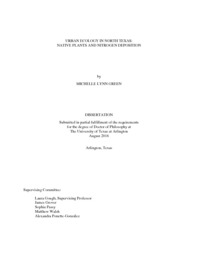
ATTENTION: The works hosted here are being migrated to a new repository that will consolidate resources, improve discoverability, and better show UTA's research impact on the global community. We will update authors as the migration progresses. Please see MavMatrix for more information.
Show simple item record
| dc.contributor.advisor | Gough, Laura | |
| dc.creator | Green, Michelle Lynn | |
| dc.date.accessioned | 2023-09-11T15:14:05Z | |
| dc.date.available | 2023-09-11T15:14:05Z | |
| dc.date.created | 2016-08 | |
| dc.date.submitted | August 2016 | |
| dc.identifier.uri | http://hdl.handle.net/10106/31686 | |
| dc.description.abstract | Globally, the human population continues to grow and move into urban areas causing a range of effects on local ecosystems. Elevated temperatures, altered hydrology, and higher concentrations of atmospheric pollutants in urban environments create novel conditions for resident organisms. My research focused on one particular aspect of human alteration to urban environments – nitrogen (N) deposition – and its effects on native plants across an urban to rural gradient in the southern Great Plains, North Texas (NTX), USA.
Nitrogen oxides (NOx) – the product of combustion and precursor to nitrate deposition in precipitation – were significantly positively correlated with impervious surface area, a measure of urban development, in NTX. Dissolved inorganic nitrogen deposition (composed of nitrate and ammonium) was also greater in the developed parts of NTX than in the surrounding rural area. Bulk N deposition in NTX was dominated by ammonium suggesting that fertilizers are likely an important source of N in rural and urban environments.
Native plant responses to these differences in N deposition were subtle. Naturally occurring native post oak trees (Quercus stellata) had similar tissue quality (carbon:nitrogen ratio) across the gradient. Little bluestem (Schizachryium scoparium) and Texas wintergrass (Nasella leucotricha), native perennial grasses, grew similarly when planted at six sites along the gradient. However, little bluestem plants taken from urban and rural remnant prairie sites and grown together in a common garden differed in some plant characteristics, suggesting genetic divergence among these populations.
Native plants provide ecosystem services including cooling, carbon sequestration, erosion control, flood mitigation, and human health benefits. Because NTX is one of the most rapidly expanding urban areas, understanding the impacts of anthropogenic N deposition on native plants is crucial to maintaining ecosystem integrity in the southern Great Plains. | |
| dc.format.mimetype | application/pdf | |
| dc.subject | urban ecology | |
| dc.subject | nitrogen deposition | |
| dc.subject | nitrogen | |
| dc.subject | little bluestem | |
| dc.subject | Texas wintergrass | |
| dc.subject | post oak | |
| dc.title | Urban Ecology in North Texas: Native Plants and Nitrogen Deposition | |
| dc.type | Thesis | |
| dc.date.updated | 2023-09-11T15:14:05Z | |
| thesis.degree.department | Biology | |
| thesis.degree.grantor | The University of Texas at Arlington | |
| thesis.degree.level | Doctoral | |
| thesis.degree.name | Doctor of Philosophy in Quantative Biology | |
| dc.type.material | text | |
| dc.creator.orcid | 0000-0002-3795-3396 | |
Files in this item
- Name:
- GREEN-DISSERTATION-2016.pdf
- Size:
- 2.391Mb
- Format:
- PDF
This item appears in the following Collection(s)
Show simple item record


